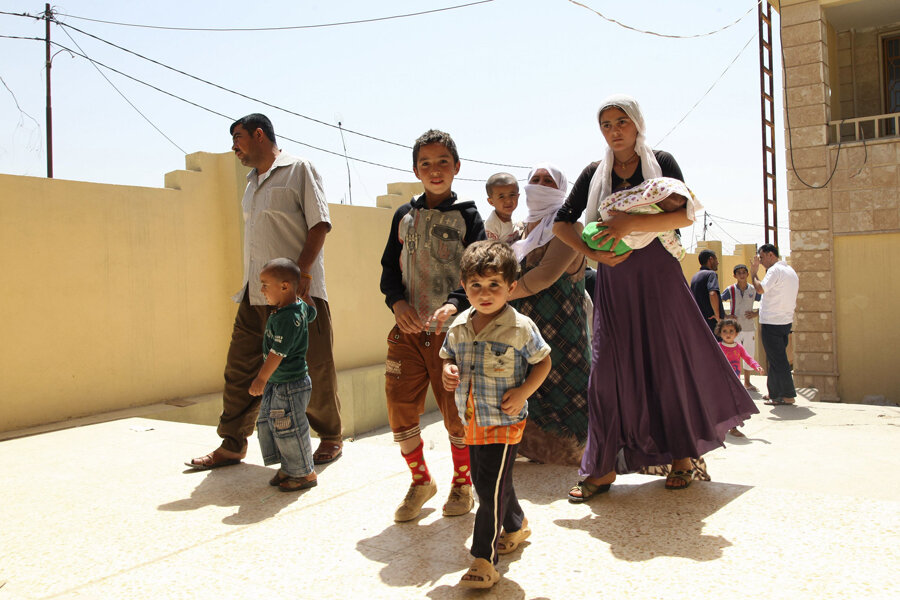Iraq's jihadis have vowed to wipe out the Yazidis. Who are they?
Loading...
The arrival of the self-styled "Islamic State" in the northern Iraqi town of Sinjar over the weekend sent the native religious minority fleeing. Yazidis, labeled by IS (formerly the Islamic State of Iraq and the Levant, or ISIS) "devil worshipers," have a long history of persecution.
Forty Yazidi children were reported killed and reports of forced conversions and murders have now emerged. A Yazidi parliamentarian fleeing northern Iraq told the Washington Post, “In our history, we have suffered 72 massacres. We are worried Sinjar could be a 73rd.”
The Sinjar area, near the border with Syria, is strategically important for IS, just 50 miles from Mosul. The United Nations has said close to 200,000 have fled the area, calling it a “humanitarian tragedy.”
Who are the Yazidis?
Yazidis (sometimes spelled Yezidis), belong to an ethno-religious group that predates Islam and has roots in Zoroastrianism, a monotheistic religion that developed in ancient Persia around 600 BC (an earlier version of this article incorrectly stated the estimated time of the faith's founding). Yazidis have been described as a “Kurdish heterodox group," meaning that they're ethnic Kurds, but outside the mainstream of the community and culture.
Over time they have incorporated aspects of Christianity, Islam, and Judaism into their beliefs. Much of the faith remains shrouded in mystery, with outsiders not allowed to convert and believers not willing to share details of their rituals.
Yazidis are found mostly in northern Iraq, Iran, Syria, and Turkey, with a smaller population in the Caucasus. The exact size of the Yazidi population is unknown, but estimates run as high as 600,000 (although with violence in Iraq in recent years the number is most likely lower).
Many Yazidis have immigrated to Europe, where their religious beliefs have made headlines for incidents such as the honor killing of a Yazidi woman who was dating a German man. Germany has one of the largest Yazidi populations in Europe. Traditionally, the Yazidi religion does not allow Yazidis to marry outside the faith.
Most Yazidis speak Kurmanji, northern Kurdish, and it is the language used for passing on religious traditions.
What are their beliefs?
Yazidis believe in one God and worship seven angels. Melek Taus, known as the Peacock Angel, plays the most important role. Worship of the Peacock Angel is where the label “devil worshiper” stems from. Christianity and Islam view the Peacock Angel as a fallen angel or devil for refusing to bow before Adam. Yazidis interpret this as a test of the Peacock Angel's commitment to God and see the Peacock Angel as the chief of God's angels.
According to reports, Yazidis pray three times a day, always facing the direction of the sun. Yazidi society is organized in a caste system with divisions between clerics and laymen. There are taboos against wearing blue and eating lettuce, but like many aspects of Yazidi belief, it remains unclear if these are always closely followed.
In the 12th century, Abi ibn Musafir led a Yazidi revival – in some ways he founded the version of the faith that's persisted since – and his tomb at Lalish in northern Iraq has become a sacred spot. Many Yazidis who have fled from Sinjar are seeking shelter there.
When and why have they been targeted?
Yazidis have been mislabeled “devil worshippers,” which has led to their persecution over the centuries. In the 1800s, Ottoman troops carried out many killings of the Yazidis. Under Saddam Hussein, many of their villages were destroyed in fighting against Kurdish groups.
In recent years, pressure on Yazidis to convert to Islam has mounted. In 2007 the Islamic State of Iraq and the Levant, the group that evolved into the current incarnation of IS, issued a fatwa that all Yazidis should be killed. This prompted around 70,000 Yazidis to flee Iraq.
That same year more than 500 Yazidis were killed when two trucks with explosives destroyed two villages. In another case, 23 Yazidis were killed in reprisal for an honor killing of a Yazidi woman who had converted to Islam. Gunmen stopped a bus and had all Christian passengers disembark. They later killed all of the Yazidis.
The son of the Yazidis spiritual leader, Baba Sheikh, told The New York Times, “Everyone considers us infidels. Sunnis and Shiites are killing each other even though they are both Muslims, so imagine what they will do to us, people from a completely different religion.”






